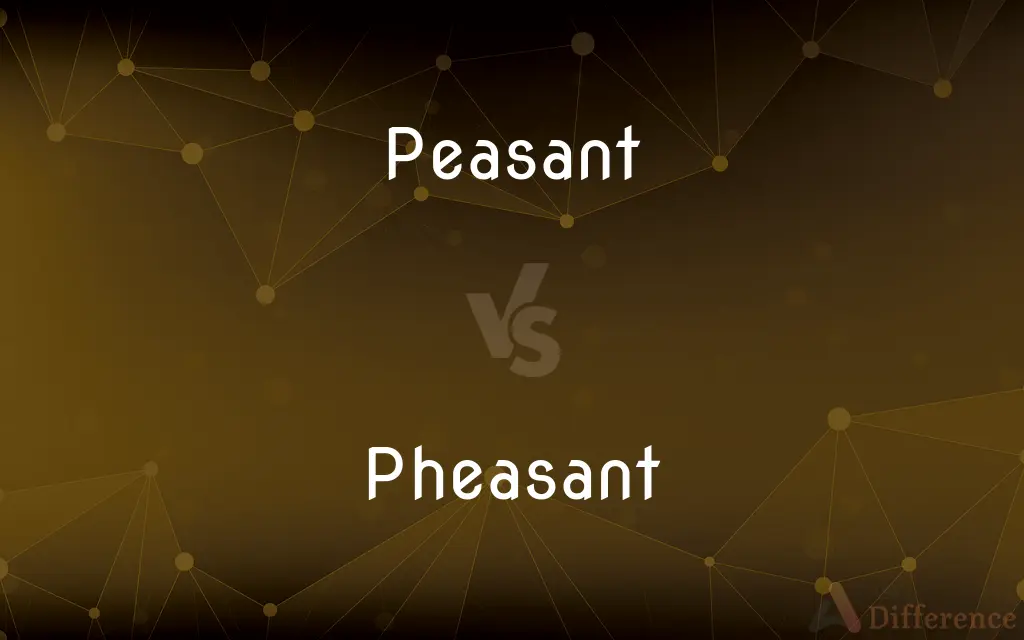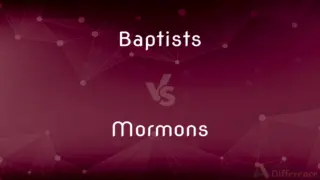Peasant vs. Pheasant — What's the Difference?
By Fiza Rafique & Maham Liaqat — Updated on March 29, 2024
A peasant is a pre-industrial agricultural laborer or farmer, while a pheasant is a type of bird known for its colorful plumage and game qualities.

Difference Between Peasant and Pheasant
Table of Contents
ADVERTISEMENT
Key Differences
Peasants historically refer to members of the lower social class engaged in agriculture, often under feudal lords, providing labor in exchange for the right to live on the land and cultivate their own plots. Pheasants, on the other hand, are birds that belong to the family Phasianidae, known for their bright feathers and being hunted as game.
Peasants have played a crucial role in the agricultural development and history of many countries, working on farms to produce food for the population. Whereas pheasants are often associated with hunting and countryside sport, besides their role in the ecosystem as part of the local wildlife.
In terms of social structure, peasants were often subject to economic and political pressures, with limited rights and freedoms during the feudal system. Pheasants, being birds, do not engage in social structures created by humans but have their behaviors and patterns influenced by their environment and the need for survival.
Culturally, peasants have been depicted in art, literature, and folklore, often symbolizing the rural life, hardship, and the working class. Pheasants are also a popular motif in art and culture, symbolizing beauty, and are often used in game dishes, highlighting their culinary value.
While the term "peasant" has evolved over time, sometimes used derogatorily, it also reflects the changing agricultural practices and socio-economic statuses. Pheasants, as a species, have seen variations in their population due to hunting, habitat loss, and conservation efforts, illustrating the impact of human activities on wildlife.
ADVERTISEMENT
Comparison Chart
Definition
A low-ranking member of a feudal society or rural laborer
A bird in the family Phasianidae, known for its colorful plumage
Role
Agricultural labor and farming
Game bird, part of wildlife
Historical Context
Associated with feudalism and agricultural societies
Hunted for sport and food, part of cultural depictions
Cultural Significance
Symbolizes rural life and labor
Represents beauty, culinary delicacy in game dishes
Impact of Human Activity
Socio-economic status and rights influenced by changing agricultural practices
Population affected by hunting, conservation efforts
Compare with Definitions
Peasant
Historically, a member of a class situated at the bottom of a societal hierarchy.
The rebellion was led by peasants demanding more rights.
Pheasant
Often hunted for sport and for its meat, considered a delicacy in many cultures.
For dinner, they served roasted pheasant with a side of wild rice.
Peasant
A rural farmer or agricultural laborer, especially in a historical or feudal context.
The peasants toiled in the fields from dawn until dusk.
Pheasant
Found in various parts of the world, adapted to different habitats from forests to fields.
The ring-necked pheasant, introduced in North America, has thrived in agricultural lands.
Peasant
In modern usage, sometimes applied to individuals living in poverty with limited means.
The novel explores the lives of peasants in the 19th century, struggling for survival.
Pheasant
Symbolizes beauty and nature in various cultures, featured in art and stories.
The painting depicted a pheasant amidst a lush, verdant landscape.
Peasant
A person of low social status, often associated with manual labor and rural life.
Medieval peasants were bound to the land they worked on.
Pheasant
A type of large game bird known for its bright plumage and long tail.
The hunter spotted a pheasant through the trees, its feathers glistening in the sun.
Peasant
In a derogatory sense, someone considered to be of low intelligence or culture.
He dismissed their concerns with a wave, calling them uninformed peasants.
Pheasant
Subject to conservation efforts due to habitat loss and hunting pressures.
Conservationists have launched a program to protect the pheasant's dwindling habitat.
Peasant
A peasant is a pre-industrial agricultural laborer or a farmer with limited land-ownership, especially one living in the Middle Ages under feudalism and paying rent, tax, fees, or services to a landlord. In Europe, three classes of peasants existed: slave, serf, and free tenant.
Pheasant
Pheasants () are birds of several genera within the subfamily Phasianinae, of the family Phasianidae in the order Galliformes. Though they can be found world over in introduced (and captive) populations, the pheasant genera native range is restricted to Asia.
Peasant
A poor smallholder or agricultural labourer of low social status (chiefly in historical use or with reference to subsistence farming in poorer countries)
Peasant farmers
Pheasant
A large long-tailed game bird native to Asia, the male of which typically has very showy plumage.
Peasant
A member of a class of small farmers and farm laborers, especially in a preindustrial or underdeveloped society.
Pheasant
Any of various game birds of the family Phasianidae, characteristically having a long tail, especially the ring-necked pheasant. The males of many species have brilliantly colored plumage.
Peasant
A person who lives in a rural area; a rustic.
Pheasant
Any of several other birds that resemble a pheasant, such as a partridge.
Peasant
A person who is considered crude or uncouth; a boor.
Pheasant
A bird of family Phasianidae, often hunted for food.
Peasant
A member of the lowly social class that toils on the land, constituted by small farmers and tenants, sharecroppers, farmhands and other laborers on the land where they form the main labor force in agriculture and horticulture.
Pheasant
Any one of numerous species of large gallinaceous birds of the genus Phasianus, and many other genera of the family Phasianidæ, found chiefly in Asia.
Peasant
A country person.
Pheasant
The ruffed grouse.
Peasant
(pejorative) An uncouth, crude or ill-bred person.
Pheasant
Large long-tailed gallinaceous bird native to the Old World but introduced elsewhere
Peasant
(strategy games) A worker unit.
Pheasant
Flesh of a pheasant; usually braised
Peasant
(attributive) Characteristic of or relating to a peasant or peasants; unsophisticated.
Peasant class
Peasant
Lowly, vulgar; reprehensible; dishonest.
Peasant
A countryman; a rustic; especially, one of the lowest class of tillers of the soil in European countries.
Peasant
Rustic, rural.
Peasant
A country person
Peasant
One of a (chiefly European) class of agricultural laborers
Peasant
A crude uncouth ill-bred person lacking culture or refinement
Common Curiosities
Are there different types of peasants?
Yes, the term can refer to various levels of rural laborers or farmers, depending on the historical and geographical context.
What is a pheasant?
A pheasant is a bird known for its colorful plumage and is often associated with game hunting.
What is a peasant?
A peasant is typically a rural agricultural laborer or farmer, particularly in historical or feudal contexts.
How did peasants live in historical times?
Historically, peasants lived in simple conditions, working the land under the control of feudal lords or landowners.
Why are pheasants hunted?
Pheasants are hunted for sport and their meat, which is considered a delicacy in many cultures.
Did peasants only work in agriculture?
While primarily involved in agriculture, some peasants also engaged in crafts, trade, and other occupations to supplement their income.
What are the conservation status of pheasants?
The conservation status of pheasants varies by species, with some being common while others are endangered.
What challenges do peasants face today?
Modern peasants may face challenges like poverty, lack of access to land, and impacts of climate change on agriculture.
Are pheasants good to eat?
Pheasant meat is highly prized in culinary circles for its flavor, often used in game dishes.
How did the feudal system affect peasants?
The feudal system often resulted in peasants living in servitude or dependence on lords for protection and land to work.
How can one participate in pheasant hunting?
Pheasant hunting usually requires a license, and participants often engage in it as a sport or for food during specific seasons.
What role do peasants play in society today?
Today, peasants can be seen as smallholder or subsistence farmers, contributing significantly to local food systems and economies.
Can pheasants be found worldwide?
Pheasants are native to Asia but have been introduced to other parts of the world, including North America and Europe.
What is being done to conserve pheasant populations?
Conservation efforts include habitat restoration, hunting regulations, and breeding programs to ensure sustainable populations.
How do pheasants adapt to different environments?
Pheasants adapt through their diet, breeding habits, and habitat preferences, thriving in both woodland and agricultural settings.
Share Your Discovery

Previous Comparison
Baptists vs. Mormons
Next Comparison
Cedarwood vs. CedarAuthor Spotlight
Written by
Fiza RafiqueFiza Rafique is a skilled content writer at AskDifference.com, where she meticulously refines and enhances written pieces. Drawing from her vast editorial expertise, Fiza ensures clarity, accuracy, and precision in every article. Passionate about language, she continually seeks to elevate the quality of content for readers worldwide.
Co-written by
Maham Liaqat















































